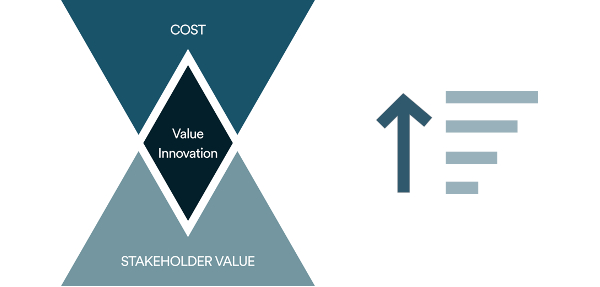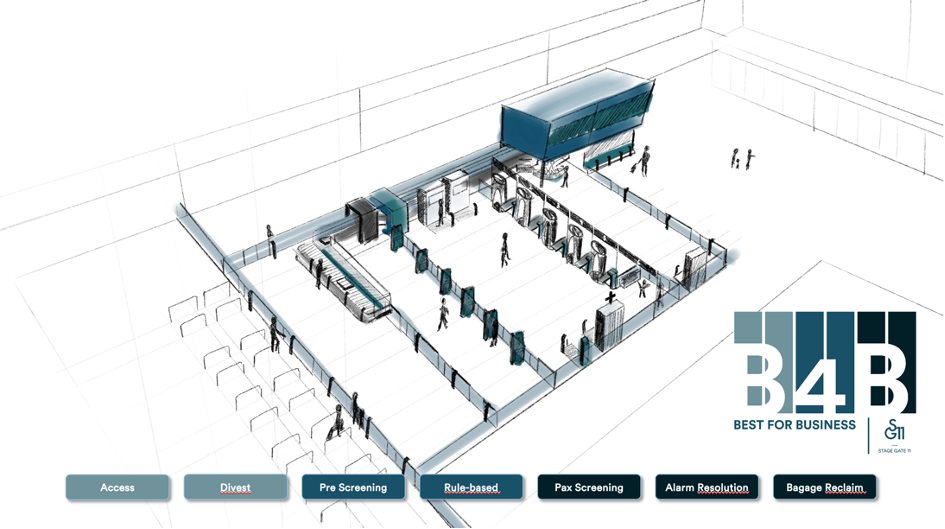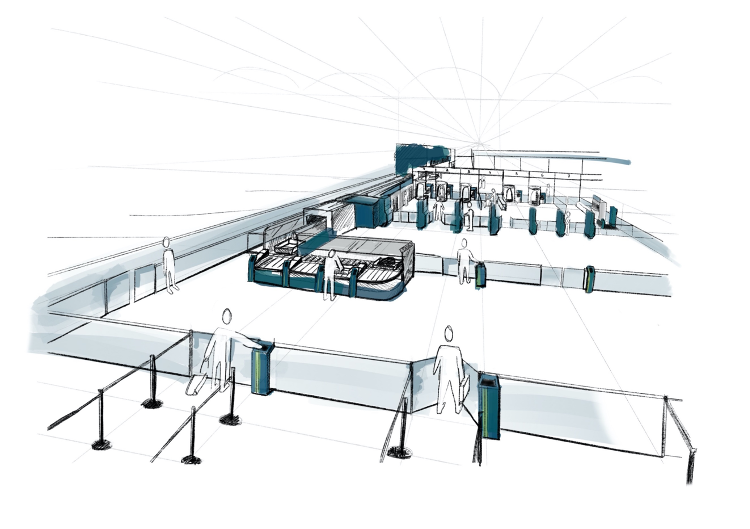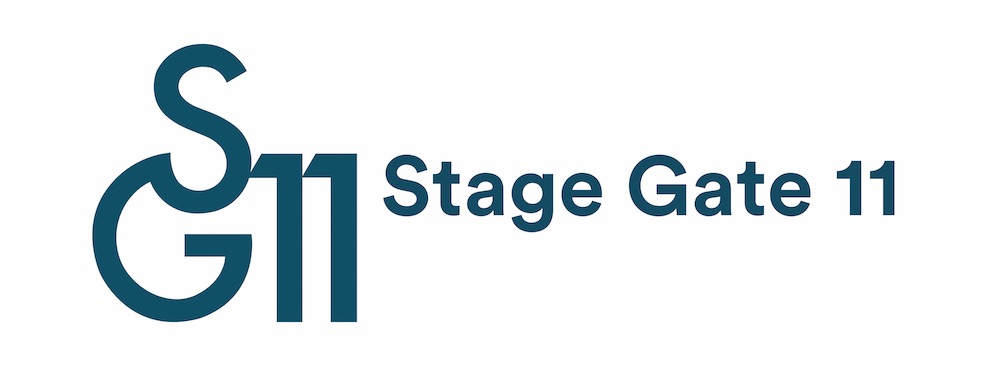Our view on future Aviation Security concepts
| Company | Stage Gate 11 B.V. |
|---|---|
| Date | 12.01.2022 |
A layer based approach with Best for Business security solutions
In our opinion future security concepts generally need to coop with 3 aspects:
- Lower costs (labour, equipment)
- More flexibility and scalability in fixed m2 (growth of passengers, replacement of equipment)
- Better experience for passengers and agents (self-service, attractive and with a high degree of hygiene)
In essence, this ambition is best tackled with a Blue Ocean Strategy approach.
This innovation theory focusses on creating new concepts, based on value innovation. Value innovation for security screening is a holistic view on security processes, creating a concept based on lower costs, combined with added value for all stakeholders involved, including passenger, agent, security and airport.
Embracing this theory and our Best for Business philosophy, our vision on the security filter of the near future is a layer-based screening approach. Providing an intuitive and scalable solution to the challenges which we know are facing.

Layer-based security approach
Scalability of solutions is a boundary condition which deserves a prominent spot on the list of KPI’s. Recent periods have made it quite clear once more as peak weeks and lulls have been a common challenge of many types of airports.
The characteristics and benefits of our vision on new security concept are aimed at providing an answer to certain parts of this challenge. The process is prominently divided into layers, which follow onto the previous layers as to guide the passengers through the security filter. Passengers are only assisted where needed, technology is used when possible.
This self-service approach allows passengers to proceed at their own pace, maximising their individual efficiency, as well as the overall checkpoint efficiency. Enabling travel-savvy passengers to move through concept faster, while passengers requiring assistance can take their time to proceed with each step as they grasp what step they need to take next.

One of the pivotal points of the operation of this concept is the division of the passenger and its carry-on baggage. Those items are divested early, and only after completing the passenger screening, the carry-on bag may be retrieved. By doing this, the linearity which is inherent in the security screening, is not required, and other modalities can be envisioned to complete the screening of the passenger.
Another key point is the unique identification of the passenger and the linkage of the passenger to its carry-on bag. This notion is one of the key points in the implementation of the presented concept. By doing this, the linkage between passenger and bag is secured, and possible alarm resolution on the bag with the passenger present, remains possible.
Identifying the passengers as they pass through the filter, also allows to keep a momentary record of the screening, by providing the screening result of the passenger at each step. By issuing a means of identification, this momentary record can be kept and evaluated throughout the passage of the passenger through the filter. Egress from the filter is only possible through a completed screening record. Having this identification per passenger, creates the opportunity for an individual screening route, based on characteristics (rule-based) of the person.
By using layers, the various steps of screening can be parallelized. This parallelization has several benefits. In the case of eventual equipment breakdown, the filter remains functional, just not that specific equipment.

Beyond this, the layer-based approach allows many interesting choices, such as rule-based screening. Automated solutions such as pre-screening devices may allow for such an approach, thereby increasing overall efficiency and reducing the numbers of false alarms.
Pre-screening also allows to implement additional rule-based screening, as certain types of pre-alarms may be identified, and handles through heightened screening in case of certain observed pre-conditions. All these solutions would work in automated fashion and be scalable e.g. through threat level assessment.
A final point which is gleaned from the separation of the Carry-on bag and the passenger at the beginning of the filter, is an observation that carry-on bags may be reclaimed at the end of the filter. This would be in-line with the current regime.
However, the notion that the carry-on bag and the passenger are separated, also brings into view the possible point that the passenger may only wish to have their bag returned to them, half an hour before the boarding, or upon entering the lounge, or at the gate. Many scenarios exist, some of which could potentially be marketable. Moreover, with potential delivery to gate or lounge, shopping may be simplified by offering a touchscreen kiosk which allows products to be purchased and automatically be added to option of choice for the return of the passengers’ cabin bag.
Notions like these would allow to maximize shopping possibilities, while not having to increase floor space as central warehousing on a non-premium location would be sufficient to provide fulfilment. Creating an optional carry-on baggage delivery with optional purchase of duty-free items is offering a revenue base for a cost-based security operation.
Unique Selling Points
The characteristics and benefits of a layer-based security approach not only optimises security, these also enable new increased value and business propositions. Each layer, as well as the total concept, contributes value by lowering costs, offering scalability and providing a better experience for passengers and agents.
Looking at the total concept, introducing layers of screening activities opposed to a fixed security lane offers:
- Less vulnerability to the malfunctioning of a single solution.
- Scalable per screening layer.
- Interchangeability of different brands.
The characteristics and benefits by the division of passenger and bags:
- Further optimisation of the process enabled.
- Increased passenger experience.
- Added value for passengers and the possibility to create new revenue stream for airport and airlines.
The characteristics and benefits by adding pre-screening layer with identifier:
- Changing role of agents.
- Personal passenger screening route.
- Efficiency through rule-based scenarios
- Flexibility by creating temporary setups within specific layer
Best 4 Business security solutions
At SG11, developing new security concepts is in our veins. Our vision on future proof security concepts is that, besides security capabilities, solutions should also include business aspects as well. Meaning, on all concepts we focus on security capabilities as well as lane throughput, thus a positive business case and optimized passenger experience. Adding value for all users and stakeholders is the multiple angle way of looking at our solutions. This holistic approach is our standard to be able to label our innovation as: Best for Business and connects to our vision on airport security in the near future.
This insight is just an outline of our vision on future aviation security concepts.
Interested in an in-depth discussion on this topic? Give us a call!
All our propositions today and new concepts to come, meet this Best for Business standard. Check our product page for more information.

